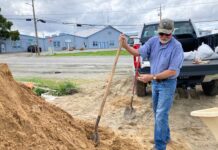A look at some of the harmful compounds South Valley and
Hollister residents are exposed to
Pollutants are all around us. A simple search for toxic
chemicals in the local environment turned up a few dozen answers.
Below is a list of just a few of the pollutants monitored by the
Bay Area Air Quality Management District to those controlled by the
United States Environmental Protection Agency to those cited by
local environmental groups as a concern.
A look at some of the harmful compounds South Valley and Hollister residents are exposed to
Pollutants are all around us. A simple search for toxic chemicals in the local environment turned up a few dozen answers. Below is a list of just a few of the pollutants monitored by the Bay Area Air Quality Management District to those controlled by the United States Environmental Protection Agency to those cited by local environmental groups as a concern.
The Environmental Protection Agency allows some companies to apply for permits to release some chemicals, such as Benzoperylene, into the environment, while other chemicals found in local water or airways are under investigation, such as the Perchlorate plume in South County. These chemicals don’t necessarily exceed EPA regulations, but they are ones that are being closely monitored in our region.
Toxins are far reaching and often spread effects long distances from their source. Smog, or Ozone, filters down from heavy commute traffic in San Francisco to South County, adding to the pollutants already in the air from local commuters. Nitrates that filter into the Pájaro River at the start of its journey, end in the Monterey Bay, with negative effects on marine life.
Here are some of the toxins reported by the EPA, BAAQMD and the Pájaro River Watershed Committee, their effects and solutions to dealing with them.
What you breathe:
Ozone – A mixture of nitric oxides close to the ground, not to be confused with the Ozone layer high in the atmosphere that protects from ultra violet rays. Ozone is a main ingredient in smog and its maximum level is set at 12 parts per billion.
Where: It is in the air all around us. A main cause is diesel and gasoline emissions, especially in areas with many commuters.
Effects: Short-term symptoms are shortness of breath, chest pain when inhaling deeply, wheezing and coughing. Long-term exposure to high levels of ozone leads to reductions in lung function, inflammation of the lung lining and increased respiratory discomfort.
Solution: Alternative transportation and fuels are ways to lower the levels of ozone near ground level. “Spare the Air” days are called when local air quality is at its worse. Ozone problems peak between May and October.
Particulate Matter – A combination of solid and liquid particles. Particles that are of most concern are those smaller than 2.5 micrometers, or 30 times smaller than a strand of hair, because they can get into lung tissues.
Where: They can be released at construction sites, unpaved roads and by fireplaces and woodstoves.
Effect: Asthma symptoms, decreased lung function, increased hospital admissions and premature death.
Solution: Some cities, such as Gilroy, have passed a city law to reduce wood-burning fireplaces in new developments. Those with fireplaces can use alternatives to wood, such as Duraflame logs, which release fewer toxins into the air.
Benzene – A clear, colorless aromatic liquid used in making plastics, rubber resins and synthetic fibers. The maximum level is set at 5 parts per billion.
Where: It is released into the air from fumes or exhaust of motor vehicles. Tobacco smoke accounts for half the national exposure to the chemical. It also gets into waterways from spills of oil or gasoline, as well as industrial run-offs.
Effect: Over the short-term it causes nervous system disorders, immune system depression and anemia. Long-term, it can cause cancer.
Solution: Alternative transportation and fuels and limitation of second-hand smoke.
It’s in the water:
Nitrates – Nitrogen-oxygen chemicals that combine with organic and inorganic compounds. They are commonly found in fertilizers, human sewage and livestock manure. Maximum level set at 10 parts per million.
Where:Pájaro River and other local waterways
Effect: Conversion of nitrates to nitrites by the body can interfere with oxygen-carrying capacity of the blood, resulting in shortness of breath and blueness of skin. It can cause death in infants and children. Long-term exposure can lead to diuresis, increased starchy deposits and hemorrhaging of the spleen.
Solution:Monitoring of local water sources once a year to determine that nitrates are below the maximum level.
Perchlorate – A man-made chemical, though it sometimes occurs naturally, was used in the manufacturing of highway flares in South County. The maximum level for perchlorate set by California is 6 parts per billion.
Where: Water wells in Morgan Hill and San Martin, though the plume is moving south toward Hwy 152, between Hwy 101 and Foothill Boulevard. In other parts of California,
the chemical has been found in lettuce and milk.
Effect: Interferes with iodide uptake in the thyroid gland, leading to metabolism problems. It can cause development problems for children and fetuses.
Solution: Biological treatment and ion exchange technologies are being used to get drinking water down to safe levels, but more treatments are under developments. Olin Corporation, the company that manufactured the flares, is providing bottled water to residents whose water sources have more than 4 ppb.
Fecal Coliforms: – A type of bacteria that is often an indicator of other disease-causing bacteria such as typhoid, dysentery, hepatitis A and cholera.
Where: During rainfalls, coliforms can get into local water supplies and waterways through leaking septic tanks, storm drains and animal feedlots.
Effect: Minor food poisoning to cholera or paralytic shellfish poisoning.
Solution: Regular testing for coliforms with boil water advisories, beach closures and shellfish bans when the bacteria are found in high numbers.









